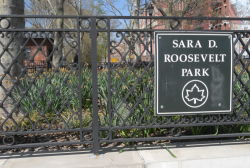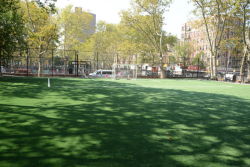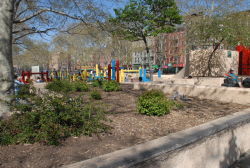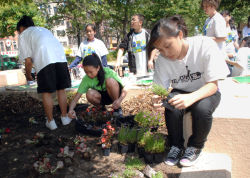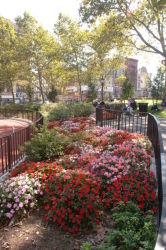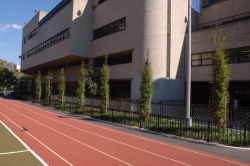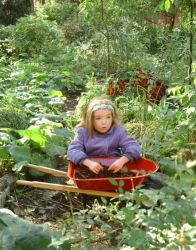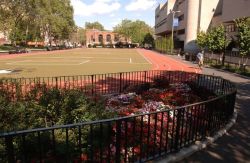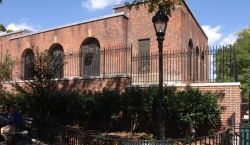Sara D. Roosevelt Park
The Daily Plant : Monday, March 9, 2009
Women's History and New York City Parks (Parks II)

Photo by Malcolm Pinckney
We continue our look at New York City parks and monuments named for important women in history.
Margaret Mead (1901-1978) was an American anthropologist famous for her studies of social structures among the people of Samoa and New Guinea. Mead worked as a research fellow and curator of ethnology at the American Museum of Natural History from 1926 until her death in 1978. The American Museum of Natural History's Hall of Pacific Peoples owes many of its exhibits to Mead's research in the South Pacific. The western section of Theodore Roosevelt Park, home of the Museum of Natural History, was named for Mead in 1979.
Eleanor Roosevelt (1884-1962) was born in New York City in 1884. The niece of President Theodore Roosevelt and the wife of President Franklin D. Roosevelt, Ms. Roosevelt distinguished herself in her own right. As a worldwide spokesperson, lecturer, and news columnist, she set about championing the cause of social reform and racial equality. Roosevelt is honored with a playground in Bedford-Stuyvesant, Brooklyn and a monument in Manhattan's Riverside Park.
Eleanor Roosevelt's mother-in-law, Sara D. Roosevelt (1854-1941), was a much beloved figure when Manhattan's Sara D. Roosevelt Park was named for her in 1934. Known as the “First Mother” -- this at a time when very few presidents' mothers were alive while they served in the Oval Office -- the park's dedication ceremony was broadcast over radio from Maine to Virginia, and attended in person by 100,000 people.
Another First Lady, Jacqueline Kennedy Onassis (1928-1994), is honored in Central Park -- the Central Park Reservoir was renamed the Jacqueline Kennedy Onassis Reservoir in 1994; she lived across the street in the penthouse apartment at 1040 Fifth Avenue.
Lillian Wald (1867-1940) was a leader in the social reform and recreation movement, and a pioneer in the field of public health. With Mary Brewster, she opened an out-patient nursing service on the Lower East Side, which expanded into the Henry Street Settlement House in 1893. In 1898, with eventual Parks Commissioner Charles Stover, she founded the Outdoor Recreation League, which sponsored some of New York City's first playgrounds. In 1902, she helped launch the world's first public nursing program and in 1912, promoted the American Red Cross's rural nursing service. Two playgrounds on Manhattan's Lower East Side are named for her.
Dr. Gertrude B. Kelly (1862-1934) studied at the Women's Medical College of the New York Infirmary for Women and Children, and became one of the first women doctors in the United States. Later, Dr. Kelly ran a surgical clinic for the poor. She was a supporter of social causes, including the Irish Republican movement and women's suffrage. The Manhattan playground was named for Kelly by Mayor Fiorello LaGuardia on May 16, 1936 and was one of five “model playgrounds” opened by Robert Moses in 1934.
Jennie Jerome Playground in the Bronx is actually named for Jeanette Jerome (1854-1921), who was born in Brooklyn, raised in New York City, and later married Lord Randolph Churchill. Jerome bore two sons -- one of whom would become Prime Minister of England and bravely guide that country through World War II. Jerome Avenue in the Bronx is named for Jennie Jerome's father.
Last November, a sculpture of Harriet Tubman (c. 1820 – 1913), created by sculpter Alison Saar, was dedicated at the crossroads of St. Nicholas Avenue, West 122nd Street and Frederick Douglass Boulevard in Harlem. Douglass once said of Tubman that except for John Brown, he knew of “no one who has willingly encountered more perils and hardships to serve our enslaved people.” In the sculpture, Saar designed stylized portraits of “anonymous passengers” of the Underground Railroad in Tubman's skirt, some of which were inspired by West African “passport masks.” Around the granite base of the monument are bronze tiles alternately depicting events in Tubman's life and traditional quilting patterns. The memorial was commissioned through the Department of Cultural Affairs’ Percent for Art program.
QUOTATION FOR THE DAY
“Determine never to be idle...It is wonderful how much may be done if we are always doing.”
Thomas Jefferson
(1743 – 1846)
Check out your park's Vital Signs
Clean & Safe
Green & Resilient
Empowered & Engaged Users
Share your feedback or learn more about how this park is part of a
Vital Park System

